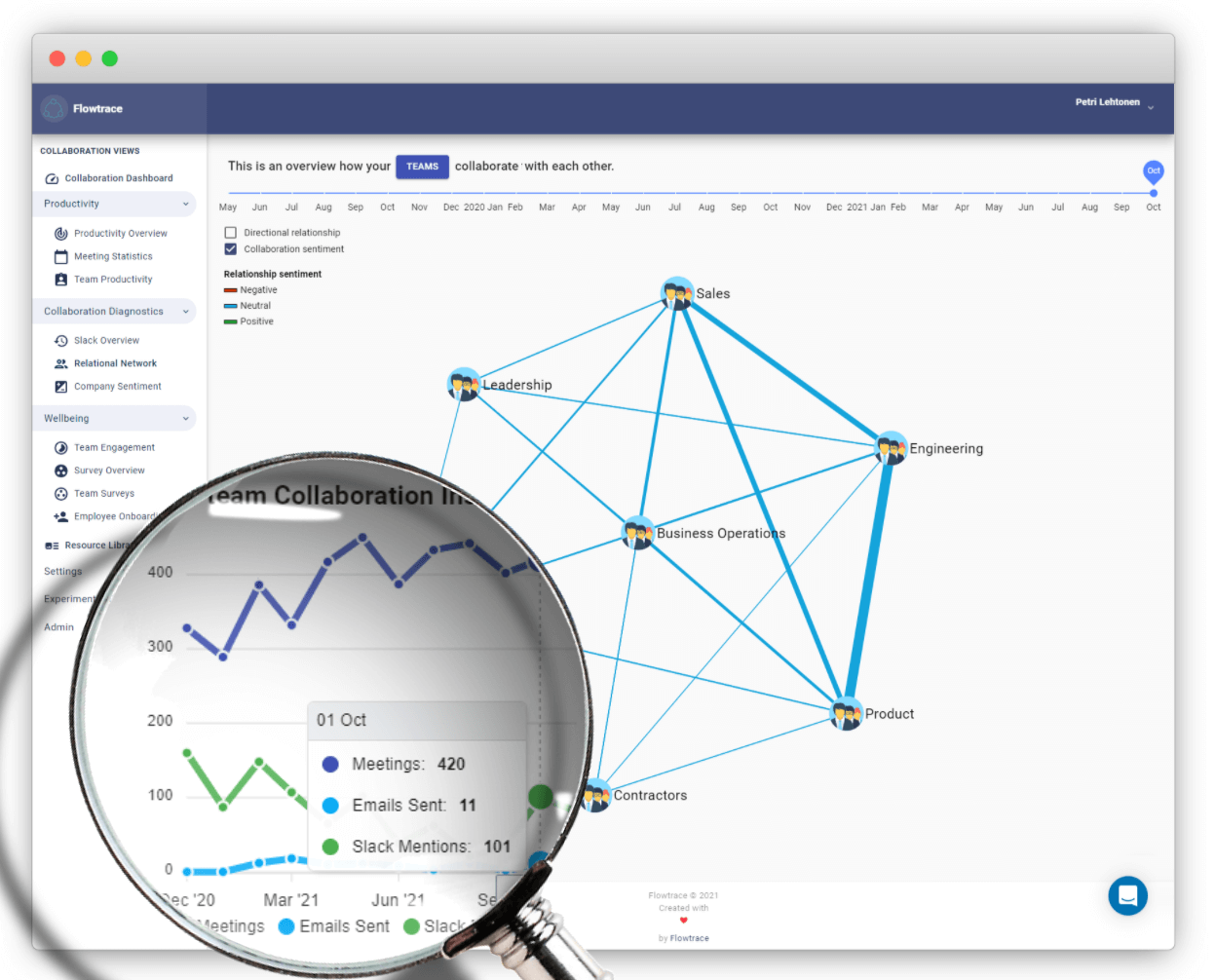In today's world, remote work has become the new norm for many businesses. The pandemic has accelerated the trend and has made remote work a necessity for many companies. While remote work has its advantages, it also brings its own set of challenges. One of the biggest challenges is the lack of visibility into the performance of remote teams.
This is where Flowtrace comes in. Flowtrace is a company analytics platform that provides insights, metrics, and recommendations for leadership teams, employees, and managers. It analyzes workplace apps and tools to create a 360-degree view of a business, covering productivity, communication, collaboration, and engagement metrics. With Flowtrace, leadership teams can have a factual view of their internal workings and prioritize which aspects of their internal business to tackle first.
In this article, we'll explore the challenges faced by remote teams and the importance of data-driven insights for their success. We'll also look at how Flowtrace helps create data-driven remote teams, and the benefits they bring.

The Pain Points of Remote Teams
Remote work may offer flexibility and convenience, but it also brings its own set of challenges. Here are some of the pain points experienced by remote teams:
Meeting Overload: Remote teams often face the problem of meeting overload, with too many meetings scheduled in a day. This can lead to burnout and decreased productivity.
Inter-team Collaboration Issues: With remote teams spread out across different locations, inter-team collaboration can become a challenge. Teams may struggle to communicate effectively, leading to siloed working and a lack of collaboration.
Outdated Documents and Information Flow Problems: Remote teams can struggle to share information effectively, leading to outdated documents and missing information. This can cause problems with decision-making and team productivity.
Lack of Visibility: Remote teams can struggle with lack of visibility into core processes and agile issues. This can lead to poor decision-making and decreased team productivity.
Lack of Metrics: Remote teams may struggle to track organizational improvements and trends, leading to a lack of metrics for impact analysis.

These pain points can lead to decreased productivity, poor decision-making, and a lack of collaboration and communication. By addressing these pain points, remote teams can improve their performance and achieve success.
The Importance of Data-Driven Insights for Remote Teams
Data-driven insights are key to creating a better work environment for remote teams. With the right data, remote teams can make informed decisions, improve collaboration and communication, and increase productivity.
Effective Decision-Making: Data-driven insights can provide remote teams with a clear understanding of what is working and what isn't. This information can be used to make informed decisions and prioritize improvements to the remote work environment.
Increased Collaboration and Communication: Data-driven insights can help remote teams identify areas where they need to improve communication and collaboration. This can help teams work together more effectively and increase productivity.
Improved Productivity: By tracking the right metrics, remote teams can identify areas where they can improve productivity. This can help teams work more efficiently and achieve better results.
Better Understanding of Culture: Data-driven insights can provide remote teams with a better understanding of what good culture looks like. By tracking communication, collaboration, and other metrics, remote teams can identify areas where they need to improve and create a better work environment.

As we see from the above, data-driven insights are essential for the ensured success of remote teams. By providing remote teams with the information they need to make informed decisions, improve collaboration and communication, and increase productivity, data-driven insights can help remote teams achieve success.
Best Practices for Remote Teams
Data-driven insights are essential for the success of remote teams, but simply tracking metrics is not enough. In this chapter, we will discuss some best practices for data-driven remote teams.
-
Choose the Right Metrics: The first step to successful data-driven insights is choosing the right metrics to track. It is important to choose metrics that are relevant to your remote team and that provide meaningful information about your work environment.
-
Make Data Accessible: To get the most out of data-driven insights, it is important to make data accessible to all team members. This can be done through tools like dashboards, reports, and alerts.
-
Use Data to Inform Decisions: Data-driven insights should be used to inform decisions, not replace them. Teams should use data to support their decision-making process and to prioritize improvements.
-
Encourage Data-Driven Culture: Creating a data-driven culture can help remote teams get the most out of data-driven insights. Teams should encourage everyone to use data to inform their decisions and to continuously improve their work environment.
-
Continuously Monitor Metrics and Trends: Data-driven insights are not a one-time effort. Teams should continuously monitor metrics and make improvements based on the data they collect.
%20(1)%20(1).webp?width=859&height=329&name=Concentrated%20bearded%20young%20man%20using%20laptop%20while%20his%20friends%20studying%20together%20(2)%20(1)%20(1).webp)
These best practices can help you and your remote teams get the most out of data-driven insights. By choosing the right metrics, making data accessible, using data to inform decisions, and continuously monitoring metrics, remote teams can create a better work environment and achieve success.
The Future of Data-Driven Remote Teams
As remote work continues to be a reality for many organizations, the importance of data-driven insights will only grow. In this chapter, we will explore the trends of the future of data-driven remote teams.
Increased Adoption of Artificial Intelligence: The use of artificial intelligence (AI) in data analysis is expected to grow, making it easier for remote teams to gather and analyze data.
Comprehensive Data Analysis: As remote work becomes more widespread, there will be an increased need for comprehensive data collection and analysis. This will enable remote teams to get a complete picture of their work environment and to make more informed decisions.
Integration of Different Data Sources: Remote teams will need to integrate data from different sources, such as communication tools, project management tools, and time tracking tools. This will enable teams to get a comprehensive view of their work environment.
Automated Insights: As AI becomes more prevalent, remote teams will be able to automate many of their data-driven insights, freeing up time for more strategic work.
AI Assisted Decision Making: The use of data-driven insights will continue to improve decision making for remote teams. Teams will be able to make more informed decisions and to prioritize improvements based on the data they collect.

The future of data-driven remote teams is bright. With the increased adoption of AI, more comprehensive data analysis, integration of different data sources, automated insights, and improved decision making, remote teams will be able to work more effectively and achieve better results.
Conclusion: Data-Driven Insights are Key to Successful Remote Teams
In this article, we have explored the importance of data-driven insights for remote teams. We have looked at how data-driven insights can help remote teams to understand their work environment, identify areas for improvement, and make more informed decisions.
Data-driven insights are essential for successful remote teams. By using data to gain a complete picture of their work environment, remote teams can improve collaboration, meetings, productivity, and engagement. This will lead to better outcomes for both the team and the organization as a whole.
As remote work continues to be a reality for many organizations, the importance of data-driven insights will only grow. Organizations that embrace data-driven insights will be better equipped to succeed in the future of work.
In conclusion, if you are a leader in a remote team, it's time to start using data-driven insights. Flowtrace can help you to gain a complete picture of your work environment, understand your team's strengths and weaknesses, and make more informed decisions. Start your journey towards a more data-driven remote team today.
